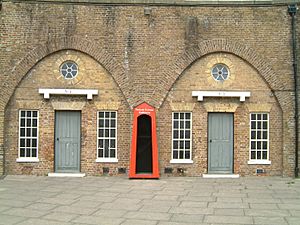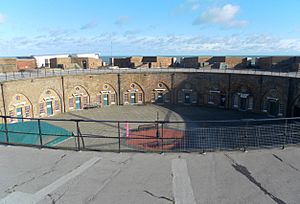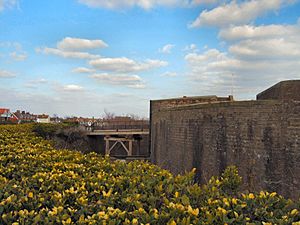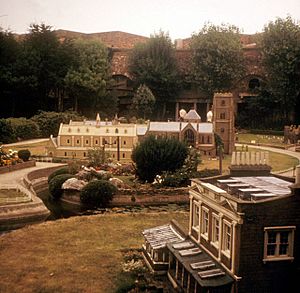Eastbourne Redoubt facts for kids
Quick facts for kids Eastbourne Redoubt |
|
|---|---|
| Eastbourne, United Kingdom | |
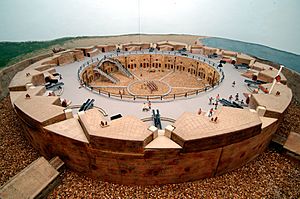
A model of the Redoubt Fortress on display at the museum
|
|
| Type | Redoubt |
| Site information | |
| Owner | Eastbourne Borough Council |
| Open to the public |
Yes |
| Site history | |
| Built | 1804 |
The Eastbourne Redoubt is a cool old circular fort right on the coast in Eastbourne, East Sussex, England. It was built way back in 1805. This was during the Napoleonic Wars, when Britain was worried about Napoleon invading. Today, the local council owns this historic building. It used to be open for everyone to visit and explore.
Contents
What is the Eastbourne Redoubt?
The redoubt is a big, round building. It measures about 68 meters (224 feet) across. It's mostly made of brick, with some granite stone.
Inside the Fort
The bottom part has 24 casemates. These are vaulted rooms that open into a central area called a parade ground. Casemate 11 was the main place to store gunpowder. Casemate 8 became a kitchen in the 1870s. Casemates 23 and 24 were changed into a detention room and two cells later on.
The Gun Platform
Above these rooms is the gun platform. This is where the big guns were placed. It has a tall wall called a parapet. This wall has openings, called embrasures, for eleven cannons. Next to each gun was a small magazine. This held ammunition for the guns during a fight. It also gave shelter to the gun crews. The low roof of these magazines created a step. Soldiers could stand on this step to fire their muskets over the parapet. This protected them from enemy infantry attacks. The main gate, which was the only way in, also goes through this parapet.
Moat and Defenses
A dry moat surrounds the redoubt. It's about 9 meters (30 feet) deep and 7 meters (25 feet) wide. On the other side of the moat, an earth slope called a glacis goes down to the ground. The moat and glacis on the sea side were removed in 1890. This happened when a sea wall and promenade were built.
Inside the moat, there are five unique covered passages called caponiers. These passages have small holes. Defenders could shoot through these holes at attackers in the moat. These caponiers were likely added in the mid-1800s. You used to enter the redoubt over a wooden drawbridge. This bridge is a modern copy of the original. A second entrance was made in 1957. It was a large doorway through the outer wall into one of the casemates.
History of the Redoubt
Why it was Built
The idea for the redoubt came from a meeting in October 1804. Leaders were discussing how to defend against Napoleon's planned invasion of the United Kingdom. French forces were gathering across the English Channel. They decided to build a line of circular forts along the coast. These forts would help protect against a French landing. Captain William Henry Ford of the Royal Engineers came up with the plan.
The original plan included 83 smaller Martello towers. Each would have one heavy gun. There would also be three larger 11-gun towers. Eastbourne was one of these locations. These bigger towers, called "grand redoubts," would be barracks and supply depots. They were also strong fortresses themselves.
Building the Fort
Construction of the Eastbourne Redoubt began on April 16, 1805. Millions of bricks were brought by boat from London. Other bricks were made nearby. The fort was built on a base of packed chalk on the shingle. Over 50,000 bricks were used in just one layer!
The redoubt first had 10 large 24-pounder guns. These were later replaced with longer-range 36-pounder guns. This was because people worried about heavier French weapons. By the time the fort was ready, the chance of invasion was very low. The guns were only fired once in anger. In 1812, two shots were fired at a French warship, but they missed.
Changes in the 1800s
By the 1830s, Europe was peaceful. Only a few soldiers and a gatekeeper lived at the redoubt. It became more of a barracks for training troops. It could hold up to 200 soldiers at a time. The fort's weapons were still improved. In 1853, the 36-pounder guns were replaced with even bigger 68-pounder guns.
In 1859, a report said that the redoubts were "not an important element of security." Still, by 1873, the fort had even more powerful guns. These included large 8-inch and 110-pounder guns. Living conditions for the soldiers also got better. A cookhouse was added in the 1870s, and a toilet block in the 1880s.
The World Wars and Beyond
During the First World War, the Royal Military Police used the redoubt. It was their headquarters and a temporary gaol (jail). After the war, Eastbourne Borough Council bought the redoubt. They wanted to turn it into a fun place for activities. In 1934, a new bandstand and a covered walkway were built nearby.
During the Second World War, the army took over the building again. They used it for storage. The remaining cannons were sold for scrap metal. In 1944, anti-aircraft guns were placed on the gun platforms. These were used to shoot down passing V-1 flying bombs.
In 1957, a businessman named Benjamin White leased the redoubt. He created a model village in the parade ground. He also made a new entrance from the moat. The bandstand walkway became the Blue Grotto Aquarium. The model village was later damaged and removed in the 1970s. The aquarium closed in 1996.
Visiting the Redoubt
As of 2025, The Redoubt Fortress is currently closed to the public.
In the past, when it was open, the redoubt and its cafe welcomed visitors from April to mid-November. People could explore the gun platform and parade ground for free. There was a charge to go inside the fortress. This included visiting the regimental museums of the Queen's Royal Irish Hussars and the Royal Sussex Regiment. The fortress also used to host many events. These included films, talks, tours, stargazing, and even ghost nights. It was a family-friendly place with a children's area. During school holidays, it offered daily activities for kids.
See also
- Listed buildings in Eastbourne


